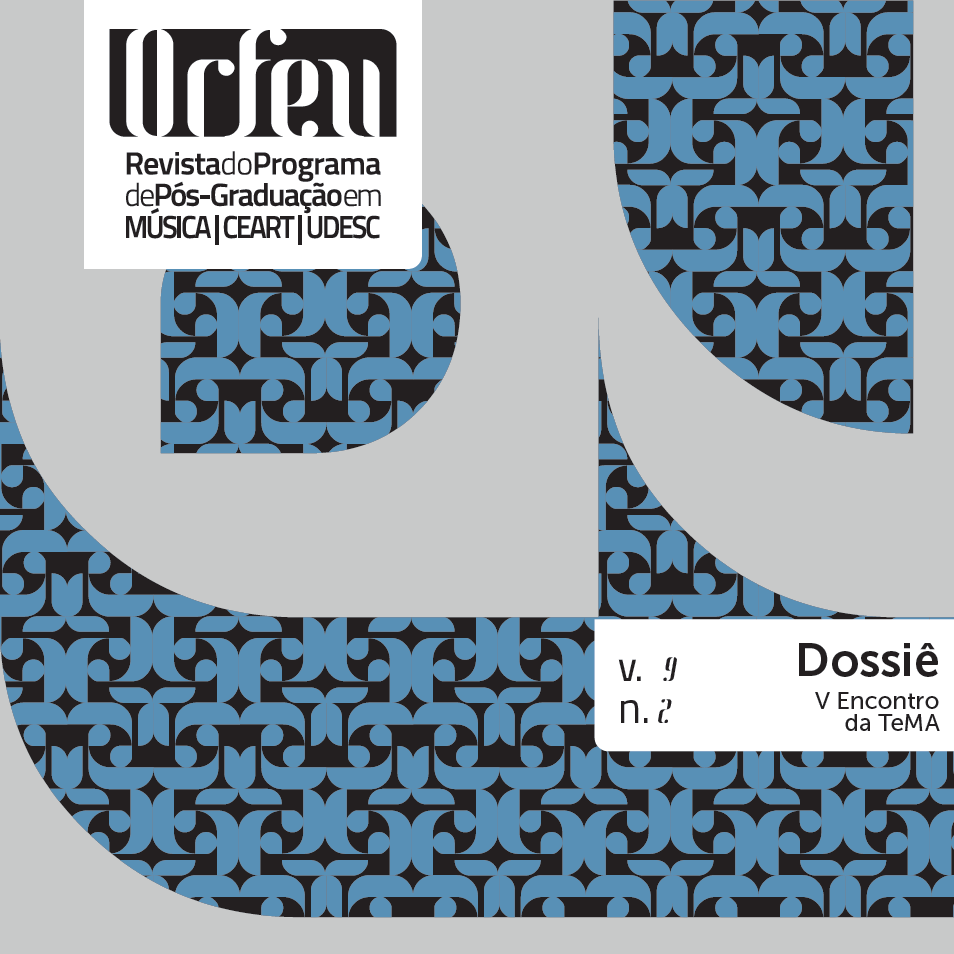As transformações e heranças do modelo pedagógico Napolitano: uma pequena reflexão a partir do tratado de João Sépe
DOI:
https://doi.org/10.5965/2525530409022024e0103Palabras clave:
Fedele Fenaroli, João Sépe, harmonia, contraponto, partimentoResumen
Este artigo explora a evolução do modelo pedagógico napolitano, concentrando-se nos trabalhos de Fedele Fenaroli (versões de 1775 e 1847) e João Sépe (lançado em 1942). Destaca como o livro “Regole musicali per i principianti di cembalo”, lançado por Fenaroli, testemunhou mudanças no pensamento musical ao longo do século XIX e possuía semelhanças com os exercícios de harmonia e contraponto, no “Tratado de Harmonia” de João Sépe, amplamente utilizado em escolas de música no Brasil. Para tanto, em um primeiro momento, comparamos o formato da escrita dos exercícios e discutimos o modelo de ensino por meio dos baixos instrucionais. Posteriormente, apresentamos um modelo comparativo dos quatro ensinamentos musicais fundamentais dos cadernos de partimento: Regra da Oitava, Cadências, Suspensões e Movimentos de Baixo. Ademais, apresentamos uma breve discussão sobre as formas de modulações que encontramos nos autores. Por fim, demonstramos como a realização harmônica, transmitida através dos baixos, ganha destaque, evidenciando a força do acorde como unidade harmônica em relação às passagens contrapontísticas.
Descargas
Citas
BARAGWANATH, Nicholas. The Solfeggio Tradition: a forgotten art of melody in the long eighteenth century. Nova Iorque: Oxford University Press, 2020.
BRAUNSCHWEIG, Karl. Embedded Dissonance in Eighteenth- and Nineteenth-Century Harmonic Theory and Practice. Music Theory Online, [S.L.], v. 29, n. 4, p. 1-21, dez. 2023. Society for Music Theory. http://dx.doi.org/10.30535/mto.29.4.1. Disponível em: https://mtosmt.org/issues/mto.23.29.4/mto.23.29.4.braunschweig.html. Acesso em: 08 abr. 2024.
BYROS, Vasili. Prelude on a Partimento: invention in the compositional pedagogy of the german states in the time of J. S. bach. Mto: Journal of the Society for Music Theory. Bloomington, p. 1-23. set. 2015. Disponível em: https://www.mtosmt.org/issues/mto.15.21.3/mto.15.21.3.byros.php. Acesso em: 08 abr. 2024.
CAFIERO, Rosa. La musica è di nuova specie, si compone senza regole: Fedele Fenaroli e la tradizione didattica napoletana fra settecento e ottocento. In: MISCIA, Gianfranco. Fedele Fenaroli il didatta e il compositore. Lanciano: Libreria Musicale Italiana, 2011. p. 171-207.
CHRISTENSEN, Thomas. Thoroughbass as music thoery. In: CHRISTENSEN, Thomas et al. Partimento and continuo playing: in theory and in practice. Leuven: Leuven University Press, 2010. p. 9-41.
DURANTE, Francesco. Principi e Regole: per accompagnare del sig.e Francesco Durante. Parma: S.I., 1760-1800. Manoscritti della Sezione musicale della Biblioteca Palatina di Parma. Disponível em: https://opac.sbn.it/risultati-ricerca-avanzata/-/opac-adv/detail/MSM0167066?. Acesso em: 08
abr. 2024.
FENAROLI, Fedele. Partimenti e regole musicali per quelli che vogliono suonare coi numeri e per i principianti di Cont. Milão: Giovanni Ricordi, 1847. 152 p. Editado por Placido Mandanici. Disponível em: https://play.google.com/books/reader?id=fzyIzUDVXz4C&pg=GBS.PP1&hl=pt. Acesso em: 08 abr. 2024.
FENAROLI, Fedele. Partimenti ossia basso numerato: opera completa di Fedele Fenaroli per uso degli alunni del reale conservatorio di napoli a Niccola Zingarelli. Paris: Conservatorio Dall'Editore Dedicata, 1814. Editado por Emanuele Imbimbo. Disponível em: https://gallica.bnf.fr/ark:/12148/bpt6k9639183h. Acesso em: 08 abr. 2024.
FENAROLI, Fedele. Regole musicali per i principianti di cembalo. Roma: S.I., 1795. 60 p. Editado por Vincenzo Mazzola-Vocola. Disponível em: https://books.google.com.br/books?id=ja0RMWzucHgC&hl=pt-BR&pg=PA19#v=onepage&q&f=false. Acesso em: 08 abr. 2024.
FENAROLI, Fedele. Regole Musicali Por Principianti Di Cembalo. 1775. Editado por Robert O. Gjerdingen. Disponível em: https://web.archive.org/web/20160719174009/http://faculty-web.at.northwestern.edu/music/gjerdingen/Partimenti/collections/Fenaroli/index.htm. Acesso em: 08 abr. 2024.
FENAROLI, Fedele. Regole musicali: per i principiante di cembalo. Veneza: Conservatorio de Música "Benedetto Marcello", 1790-99. Manuscrito, n.d.(ca.1790-99) do original de Nápoles (1775). Disponível em: https://imslp.org/wiki/Regole_musicali_per_i_principianti_di_cembalo_(Fenaroli,_Fedele). Acesso em: 08 abr. 2024.
GJERDINGEN, Robert O.. Child Composers in the Old Conservatories: how orphans became elite musicians. Nova Iorque: Oxford University Press, 2020.
GJERDINGEN, Robert O.. Music in the galant style. New York: Oxford University Press, Inc., 2007
IJZERMAN, Job. Harmony, Counterpoint, Partimento: a new method inspired by old masters. Nova Iorque: Oxford University Press, 2018.
MACHADO NETO, Diósnio et al. É assim, porque é assim que tem que ser: a retórica galante nos motetes de José Maurício, observada no uso da pedagogia dos partimenti, Musica Theorica, [S.L.], v. 5, n. 2, p. 74-141, 7 jul. 2021. Associação Brasileira de Teoria e Análise Musical (TeMA). http://dx.doi.org/10.52930/mt.v5i2.167. Disponível em: https://revistamusicatheorica.tema.mus.br/index.php/musica-theorica/article/view/167. Acesso em: 08 abr. 2024.
PAULILLO, Laines. "Tratado de Harmonia" de João Sépe editado em Nova York. Correio Paulistano. São Paulo, p. 7-7. fev. 1963. Disponível em: http://memoria.bn.br/docreader/DocReader.aspx?bib=090972_11&pagfis=14728. Acesso em: 27 abr. 2024.
RABINOVITCH, Gilad; SLOMINSKI, Johnandrew. Towards a Galant Pedagogy: Partimenti and Schemata as Tools in the Pedagogy of Eighteenth-Century Style Improvisation. Society For Music Theory, Bloomington, v. 21, n. 3, p.1-11, set. 2015. Disponível em: <http://www.mtosmt.org/issues/mto.15.21.3/mto.15.21.3.rabinovitch.php>. Acesso em: 27 abr. 2024.
TAVARES, Fernando. A Arte do Partimento em sua história, fundamentos, práticas e discussão musicológica: análise historiográfica para a consolidação de um saber para a pedagogia da música. 2021. 175 f. Dissertação (Mestrado) - Curso de Música, Escola de Comunicações e Arte, Universidade de São Paulo, São Paulo, 2021.
TAVARES, Fernando; SILVA, Gustavo Caum e; MACHADO NETO, Diósnio. Cadências do Galante: a utilização nas missas do padre José Maurício Nunes Garcia. In: X SIMPÓSIO INTERNACIONAL DE MUSICOLOGIA, 10., 2020, Goiânia. Anais. Goiânia: S.I., 2020. p. 132-143.
SANGUINETTI, Giorgio. The art of partimento: history, theory, and practice. New York: Oxford University Press, Inc., 2012.
SANGUINETTI, Giorgio. L’eredità di Fenaroli nell’Ottocento. In: CAROCCIA, Antonio; MAIONE, Paolo Giovanni; SELLER, Francesca. Giuseppe Martucci e la caduta delle Alpi. Lucca: Libreria Musicale Italiana, 2008. p. 11-34.
SANTOS, José Roberto dos. História e música em São Paulo no início do século XX: a trajetória da Banda da Força Pública. 2019. Dissertação (Mestrado em História Social) - Faculdade de Filosofia, Letras e Ciências Humanas, Universidade de São Paulo, São Paulo, 2019. doi:10.11606/D.8.2019.tde-29072019-123752. Acesso em: 2024-04-08.
SÉPE, João. Tratado de Harmonia. 10. ed. São Paulo: Ricordi Brasileira, 1942
VAN TOUR, Peter. Counterpoint and Partimento: methods of teaching composition in late eighteenth-century naples. Uppsala: Uppsala Universitet, 2015. 318 p.
VAN TOUR, Peter. UUPar: the uppsala partimento database. The Uppsala Partimento Database. 2017. Disponível em: https://www2.musik.uu.se/UUPart/UUPart.php. Acesso em: 08 abr. 2024.
Descargas
Publicado
Cómo citar
Número
Sección
Licencia
Derechos de autor 2024 Fernando Tavares, Diósnio Machado Neto

Esta obra está bajo una licencia internacional Creative Commons Atribución 4.0.






